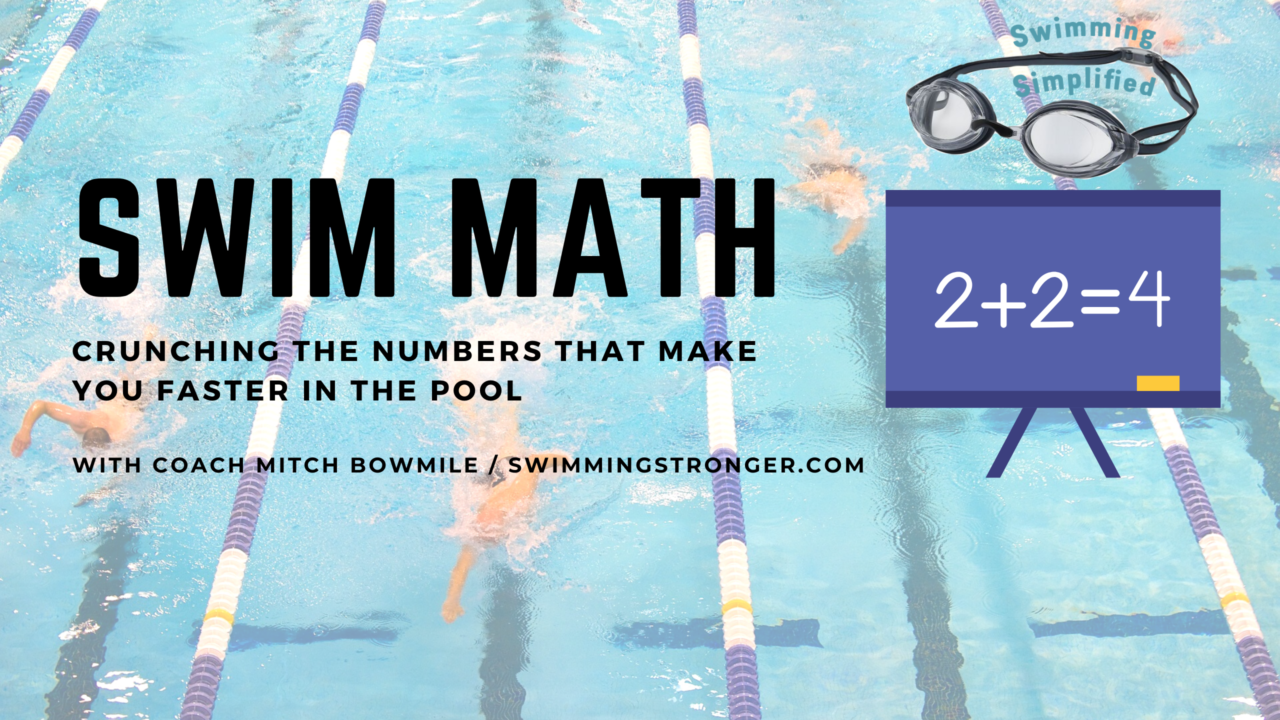Disclaimer: This video is for informational purposes. Athletes should check with their doctors and/or trainers before taking on a new exercise routine.
In Swimming Simplified coach Mitch Bowmile goes over anything and everything to do with the science of swimming and simplifies it. With information delivered in an easy-to-understand fashion, the series is designed to help bridge the gap between what coaches are asking of their athletes and their athletes’ understanding of the sport. By becoming students of the sports and grasping the fundamentals of swim training, swimmers will be able to understand the why of what they’re doing better than ever before.
As you or your swimmers begin to transition to intermediate and higher levels of training, there are going to be a lot of new and more advanced ideas thrown around.
Among the new terminology and calculations you’ll hear will relate to ‘swim math.’ While the ideal outcomes of this ‘swim math’ will vary from coach to coach and swimmer to swimmer, understanding this terminology and how the ‘swim math’ works can be crucial to understanding where you’re improving and where you need improvement.
The math can’t always be perfectly compared from one swimmer to another – a swimmer who stands 5’2 will have a different stroke cycle than a swimmer who stands 6’2 – but if you’ve been working on generating more power in each stroke, for example, these ideas at a minimum can help you measure your own improvements.
Learn about ‘swim math’ below with coach Mitch Bowmile.
Swimming revolves around numbers. Qualifying times, personal bests, rankings, splits, metres, yards, ect.
But what are the specific numbers that determine how fast you move in the pool?
Those two factors are:
1️) Stroke Rate
2️) Distance Per Stroke / Stroke Length
Stroke Rate is the speed it takes to complete one stroke cycle. It’s how fast your arms are moving.
Distance per stroke is the distance that you travel every time you take a stroke. The longer DPS, the longer the distance traveled every stroke.
Stroke Rate and DPS work in synchronicity to determine just how fast you move through the water.
Consider the following three scenarios:
- A high SR and short DPS – you’re moving your arms fast, but you’re not carrying yourself very far forward each stroke, so you’re not swimming very fast.
- A low SR and a long DPS – you’re carrying yourself very far forward each stroke, but your arms are moving so slowly that you’re not taking enough strokes to move fast, so you’re not swimming very fast.
- A high SR and a long DPS – you’re carrying yourself very far forward each stroke and you’re moving your arms fast, so you’re swimming VERY fast!
The relationship between DPS and Stroke Rate determines just how fast you go. If your arms are moving quickly and you’re moving yourself forward each stroke by a decent amount, you’re going to swim fast!
As a swimmer, you need to find the appropriate balance between stroke rate and DPS for you.
I find that most swimmers usually swim with a low stroke rate, so building up your rate is a good starting point to SWIMMING STRONGER. Then you can work on how much water you’re holding while maintaining your stroke rate.
ABOUT SWIMMING SIMPLIFIED
In Swimming Simplified coach Mitch Bowmile of www.SwimmingStronger.com goes over anything and everything to do with the science of swimming and simplifies it.
With information delivered in an easy-to-understand fashion, the series is designed to help bridge the gap between what coaches are asking of their athletes and their athlete’s understanding of the sport.
By becoming students of the sports and grasping the fundamentals of swim training, swimmers will be able to understand the why of what they’re doing better than ever before.
https://www.youtube.com/watch?v=6M0neDjFL6w

Since this is a math lesson, factor# 2 looks like a division: Distance Per Stroke / Stroke Length. Of course, this always equals 1.Distance Per Stroke (Stroke Length) appears more readable.
If I was going to have my bookshelf in the background of a swimming video, I would include at least one book by Doc Counsilman and one book by Ernie Maglischo. He has the Science of Swimming Faster book on the shelf, which, in the context of the title of this video series, should be called Swimming Complicated.
Coach is reading this so his eyes are always looking to our left. This is distracting.
Nobody swims at a constant rate so I think its also important to mention average… Read more »
That’s a really cool video.